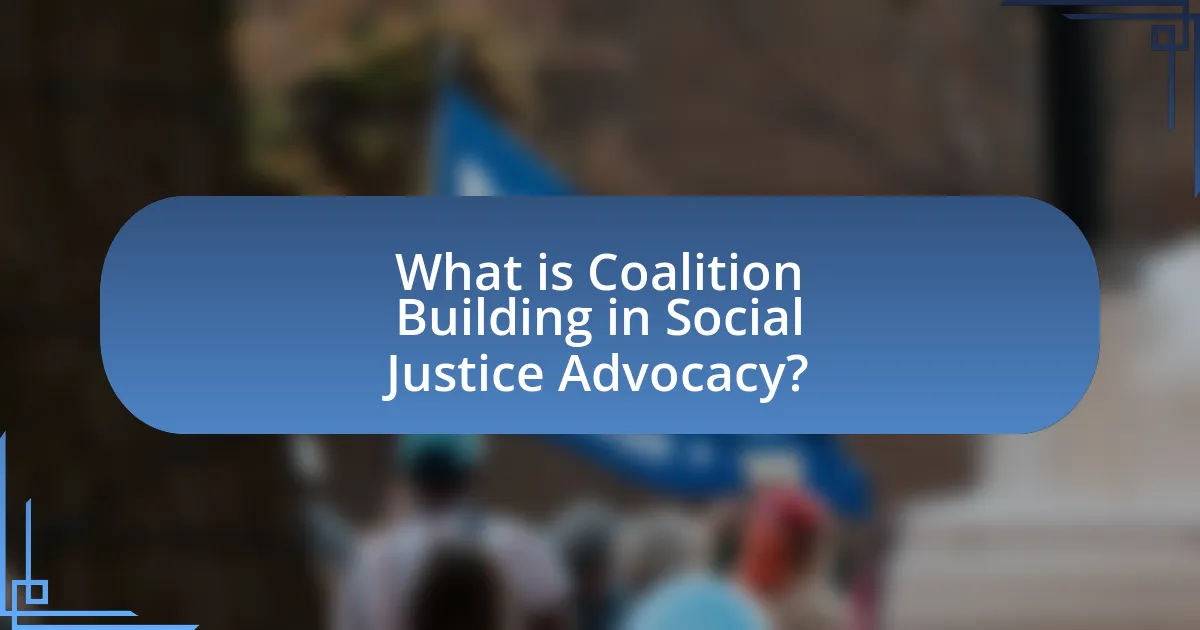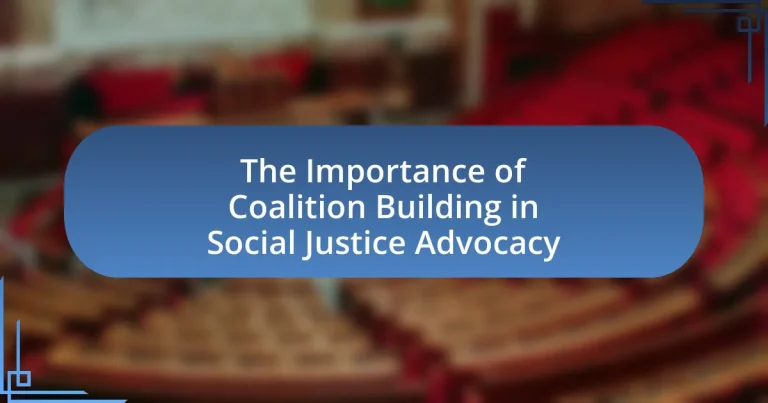Coalition building in social justice advocacy is the process of forming alliances among diverse groups to collectively address social issues and promote equity. This article explores the significance of coalition building, highlighting its role in amplifying marginalized voices, enhancing collective power, and fostering effective advocacy efforts. Key principles for successful coalitions, historical contexts, challenges faced, and strategies for strengthening collaboration are discussed, along with lessons learned from past movements. The article emphasizes the importance of shared goals, effective communication, and inclusivity in achieving sustainable social justice outcomes.

What is Coalition Building in Social Justice Advocacy?
Coalition building in social justice advocacy refers to the process of forming alliances among diverse groups to collectively address social issues and promote equity. This collaborative approach enhances the effectiveness of advocacy efforts by pooling resources, knowledge, and networks, thereby amplifying the voices of marginalized communities. Historical examples, such as the Civil Rights Movement, demonstrate how coalitions between various organizations and communities can lead to significant legislative changes and social progress.
Why is Coalition Building Essential for Social Justice Movements?
Coalition building is essential for social justice movements because it amplifies voices, resources, and influence, enabling diverse groups to unite for common goals. By collaborating, organizations can share knowledge, strategies, and mobilization efforts, which enhances their capacity to challenge systemic injustices. Historical examples, such as the Civil Rights Movement, demonstrate that coalitions among various racial, economic, and social groups were pivotal in achieving significant legislative changes, like the Civil Rights Act of 1964. This collective action not only strengthens advocacy efforts but also fosters solidarity and mutual support among marginalized communities, making coalition building a fundamental strategy for effective social justice work.
What are the key principles of effective coalition building?
The key principles of effective coalition building include shared goals, mutual respect, open communication, and inclusivity. Shared goals ensure that all members are aligned in their objectives, which fosters collaboration and commitment. Mutual respect among diverse stakeholders promotes trust and strengthens relationships, essential for long-term partnerships. Open communication facilitates transparency and encourages the sharing of ideas and resources, which enhances problem-solving capabilities. Inclusivity ensures that all voices are heard, particularly those from marginalized communities, thereby enriching the coalition’s perspective and effectiveness. These principles are supported by research indicating that coalitions with clear, shared objectives and strong interpersonal relationships are more successful in achieving their advocacy goals.
How does coalition building enhance collective power?
Coalition building enhances collective power by uniting diverse groups to amplify their influence and resources. When organizations or individuals collaborate, they combine their strengths, knowledge, and networks, which leads to a more significant impact on social justice issues. For instance, the Civil Rights Movement in the United States saw various groups, including churches, labor unions, and civil rights organizations, come together to challenge systemic racism, resulting in landmark legislation like the Civil Rights Act of 1964. This historical example illustrates how coalition building can effectively mobilize collective action, leading to substantial social change.
What are the Historical Contexts of Coalition Building in Social Justice?
Coalition building in social justice has historical contexts rooted in various movements advocating for civil rights, labor rights, and gender equality. For instance, the Civil Rights Movement of the 1960s in the United States exemplified coalition building as diverse groups, including African Americans, labor unions, and religious organizations, united to combat racial segregation and discrimination. This collaboration was crucial in achieving landmark legislation like the Civil Rights Act of 1964, which outlawed discrimination based on race, color, religion, sex, or national origin. Additionally, the feminist movements of the late 19th and early 20th centuries, which sought women’s suffrage and equal rights, also relied on coalitions among women from different social classes and ethnic backgrounds, highlighting the importance of solidarity in achieving common goals. These historical examples demonstrate that coalition building has been essential for amplifying voices and creating systemic change in social justice advocacy.
How have past coalitions influenced current social justice efforts?
Past coalitions have significantly shaped current social justice efforts by establishing frameworks for collaboration and advocacy that continue to inform contemporary movements. Historical alliances, such as the Civil Rights Movement of the 1960s, demonstrated the power of diverse groups uniting for common goals, leading to landmark legislation like the Civil Rights Act of 1964. These coalitions provided models for strategic organizing, resource sharing, and collective action, which are evident in today’s movements such as Black Lives Matter and LGBTQ+ rights advocacy. The lessons learned from past coalitions, including the importance of intersectionality and grassroots mobilization, continue to influence tactics and strategies in current social justice initiatives, ensuring that diverse voices are represented and that efforts are more inclusive and effective.
What lessons can be learned from historical coalition successes and failures?
Historical coalition successes and failures reveal critical lessons about the importance of shared goals, effective communication, and adaptability. Successful coalitions, such as the Civil Rights Movement in the 1960s, demonstrated that uniting diverse groups around a common objective can amplify impact, as seen in the passage of the Civil Rights Act of 1964. Conversely, failures, like the collapse of the Occupy Wall Street movement, highlight the risks of unclear messaging and lack of cohesive leadership, which can lead to fragmentation and diminished effectiveness. These examples underscore that clarity in purpose and strong organizational structures are essential for coalition longevity and success in social justice advocacy.
What Challenges Do Coalitions Face in Social Justice Advocacy?
Coalitions in social justice advocacy face several significant challenges, including differing priorities among member organizations, resource limitations, and internal conflicts. Differing priorities can lead to disagreements on strategies and goals, which can hinder collective action. Resource limitations, such as funding and manpower, often restrict the coalition’s ability to implement initiatives effectively. Internal conflicts, stemming from varying organizational cultures or leadership styles, can further complicate collaboration and weaken the coalition’s overall impact. These challenges are documented in studies, such as “Coalition Building in Community Organizing” by the University of California, which highlights the complexities coalitions encounter in aligning diverse interests while striving for a common purpose.
How do differing agendas impact coalition effectiveness?
Differing agendas significantly hinder coalition effectiveness by creating conflicts that impede collaboration. When coalition members prioritize their individual goals over shared objectives, it leads to misalignment in strategies and resource allocation. For instance, research by the National Coalition for Dialogue & Deliberation indicates that coalitions with clear, unified goals are 30% more likely to achieve their intended outcomes compared to those with divergent agendas. This misalignment can result in decreased trust, ineffective communication, and ultimately, the failure to mobilize collective action, which is essential in social justice advocacy.
What strategies can mitigate conflicts within coalitions?
Effective strategies to mitigate conflicts within coalitions include fostering open communication, establishing clear roles and responsibilities, and promoting shared goals. Open communication allows coalition members to express concerns and perspectives, reducing misunderstandings. Establishing clear roles ensures that each member understands their contributions, minimizing overlap and potential friction. Promoting shared goals aligns the coalition’s efforts, creating a unified purpose that can help resolve disputes. Research indicates that coalitions with defined communication protocols and shared objectives experience fewer conflicts, as evidenced by studies on collaborative governance in social movements.
How Can Coalition Building Be Strengthened?
Coalition building can be strengthened by fostering open communication and establishing shared goals among diverse groups. Effective communication ensures that all members understand each other’s perspectives and objectives, which is crucial for collaboration. Research indicates that coalitions with clear, common goals are more likely to succeed; for instance, a study by the National Network of Abortion Funds found that coalitions focused on specific, measurable outcomes achieved greater impact in advocacy efforts. Additionally, regular meetings and inclusive decision-making processes enhance trust and commitment among coalition members, further solidifying the partnership.
What Role Does Communication Play in Successful Coalitions?
Communication is essential for successful coalitions as it facilitates collaboration, builds trust, and ensures alignment among diverse stakeholders. Effective communication allows coalition members to share their goals, strategies, and resources, which enhances collective action. Research indicates that coalitions with strong communication practices are more likely to achieve their objectives, as evidenced by a study published in the “American Journal of Community Psychology,” which found that clear communication significantly improves coalition effectiveness and member satisfaction.
How can technology facilitate better communication among coalition members?
Technology can facilitate better communication among coalition members by providing platforms for real-time collaboration and information sharing. Tools such as messaging apps, video conferencing, and project management software enable coalition members to connect instantly, regardless of geographical barriers. For instance, platforms like Slack and Zoom allow for immediate discussions and decision-making, which enhances responsiveness and engagement among members. Research indicates that organizations utilizing collaborative technology report a 30% increase in team productivity, demonstrating the effectiveness of these tools in fostering communication.
What are best practices for maintaining transparency in coalitions?
Best practices for maintaining transparency in coalitions include establishing clear communication channels, regularly sharing information, and involving all members in decision-making processes. Clear communication channels ensure that all coalition members receive timely updates and can voice their opinions, fostering an environment of trust. Regularly sharing information, such as meeting minutes and financial reports, allows members to stay informed about coalition activities and resource allocation. Involving all members in decision-making processes promotes inclusivity and accountability, which are essential for maintaining transparency. These practices are supported by research indicating that transparency enhances collaboration and strengthens coalition effectiveness in social justice advocacy.
What are the Key Benefits of Coalition Building in Social Justice Advocacy?
Coalition building in social justice advocacy provides enhanced collective power, enabling diverse groups to unite for a common cause. This unity amplifies voices that may otherwise be marginalized, increasing visibility and influence in policy discussions. For instance, the 2017 Women’s March, which brought together various organizations and individuals advocating for women’s rights, demonstrated how coalition building can mobilize large numbers of people and draw significant media attention, leading to greater public awareness and political engagement. Additionally, coalitions can pool resources, share expertise, and foster innovative strategies, making advocacy efforts more effective and sustainable.
How does coalition building amplify marginalized voices?
Coalition building amplifies marginalized voices by creating a unified platform that enhances visibility and influence. When diverse groups come together, they pool resources, share knowledge, and leverage collective power to advocate for common goals, which increases the likelihood of being heard by decision-makers. For instance, the 2017 Women’s March, which united various marginalized communities, demonstrated how coalition building can mobilize large numbers of people and draw significant media attention, thereby elevating issues such as racial justice, gender equality, and LGBTQ+ rights. This collective action not only raises awareness but also pressures policymakers to address the concerns of these communities, ultimately leading to more inclusive and equitable outcomes.
What impact does coalition building have on policy change?
Coalition building significantly enhances policy change by uniting diverse stakeholders to amplify their collective influence. This collaborative approach allows for the pooling of resources, expertise, and networks, which can lead to more effective advocacy efforts. For instance, the 2017 Women’s March in the United States, which brought together various groups advocating for women’s rights, racial justice, and LGBTQ+ rights, demonstrated how coalition building can mobilize large numbers of people and draw national attention to policy issues. Research indicates that coalitions can increase the likelihood of policy adoption by presenting a unified front, thereby making it harder for policymakers to ignore the demands of a broad and diverse constituency.
What Practical Steps Can Be Taken to Build Effective Coalitions?
To build effective coalitions, organizations should first identify shared goals among diverse stakeholders. This alignment fosters collaboration and ensures that all parties are working towards a common purpose. Next, establishing clear communication channels is essential; regular meetings and updates help maintain transparency and trust among coalition members. Additionally, defining roles and responsibilities within the coalition enhances accountability and ensures that tasks are completed efficiently.
Furthermore, leveraging the strengths and resources of each member can amplify the coalition’s impact, as evidenced by successful coalitions like the Civil Rights Movement, which united various groups to achieve significant legislative changes. Lastly, evaluating the coalition’s progress and adapting strategies based on feedback and outcomes is crucial for long-term effectiveness. These steps collectively contribute to the formation of a robust coalition capable of driving social justice advocacy forward.
How can organizations identify potential coalition partners?
Organizations can identify potential coalition partners by assessing shared goals, values, and resources. This involves conducting a stakeholder analysis to pinpoint organizations with similar missions or objectives, which can be supported by data indicating that coalitions with aligned interests are more effective in achieving social justice outcomes. For instance, research shows that partnerships formed around common goals can enhance advocacy efforts, as seen in successful coalitions like the Fair Housing Alliance, which united various groups to combat housing discrimination. By leveraging networks, attending relevant events, and utilizing social media platforms, organizations can further discover and engage with potential partners who are committed to similar causes.
What are the essential elements of a coalition agreement?
The essential elements of a coalition agreement include shared goals, roles and responsibilities, decision-making processes, resource allocation, and conflict resolution mechanisms. Shared goals ensure that all coalition members are aligned in their objectives, fostering unity and purpose. Clearly defined roles and responsibilities delineate the contributions expected from each member, enhancing accountability. A transparent decision-making process allows for equitable participation and consensus-building among members. Resource allocation outlines how financial and human resources will be distributed to support coalition activities. Lastly, conflict resolution mechanisms provide a framework for addressing disagreements, ensuring the coalition remains functional and focused on its mission. These elements are critical for the effectiveness and sustainability of coalitions in social justice advocacy.
What Common Mistakes Should Be Avoided in Coalition Building?
Common mistakes to avoid in coalition building include failing to establish clear goals, neglecting to communicate effectively, and not ensuring equitable participation among all members. Establishing clear goals is crucial, as ambiguity can lead to misalignment and conflict within the coalition. Effective communication fosters trust and collaboration, while neglecting it can result in misunderstandings and disengagement. Ensuring equitable participation is vital; if certain voices dominate, the coalition may lose its diversity and effectiveness. Research indicates that coalitions with clear objectives and inclusive practices are more successful in achieving their social justice aims.
How can coalitions ensure inclusivity and representation?
Coalitions can ensure inclusivity and representation by actively engaging diverse stakeholders in decision-making processes. This involves implementing strategies such as outreach to underrepresented communities, establishing equitable leadership structures, and fostering open communication channels. Research indicates that inclusive coalitions, like the “Building Movement Project,” demonstrate improved effectiveness in advocacy efforts by reflecting the demographics of the communities they serve. By prioritizing diverse perspectives, coalitions can better address the needs and concerns of all constituents, thereby enhancing their legitimacy and impact in social justice advocacy.
What pitfalls lead to coalition disbandment?
Coalition disbandment often occurs due to a lack of shared goals among members. When coalition partners have differing priorities or visions, it can lead to conflicts and a breakdown in collaboration. For instance, research by the National Council of Nonprofits indicates that misalignment in objectives can create tension, ultimately resulting in the dissolution of the coalition. Additionally, ineffective communication and decision-making processes can exacerbate misunderstandings, further contributing to disbandment. Historical examples, such as the disintegration of the Rainbow Coalition in the 1980s, illustrate how internal disagreements and external pressures can lead to the failure of coalitions.
How Can Coalition Building Lead to Sustainable Social Justice Advocacy?
Coalition building can lead to sustainable social justice advocacy by creating a unified front that amplifies diverse voices and resources. When various organizations and individuals collaborate, they can pool their strengths, share knowledge, and mobilize larger groups for collective action. This collaborative approach enhances the effectiveness of advocacy efforts, as seen in movements like the Civil Rights Movement, where coalitions of different groups worked together to achieve significant legislative changes. Furthermore, coalitions can foster long-term relationships that sustain advocacy efforts beyond immediate campaigns, ensuring ongoing support for social justice initiatives.
What strategies promote long-term collaboration among coalition members?
Effective strategies that promote long-term collaboration among coalition members include establishing clear communication channels, fostering mutual trust, and aligning goals and values. Clear communication ensures that all members are informed and engaged, which is essential for maintaining collaboration over time. Fostering mutual trust among members encourages openness and willingness to share resources and information, which strengthens the coalition. Aligning goals and values helps to create a shared vision, making it easier for members to work together towards common objectives. Research indicates that coalitions with strong communication practices and shared values are more likely to sustain their efforts and achieve long-term success in social justice advocacy.
How can coalitions measure their impact and success over time?
Coalitions can measure their impact and success over time by establishing clear, quantifiable goals and utilizing specific metrics to assess progress. For instance, coalitions can track changes in policy, community engagement levels, or demographic shifts resulting from their initiatives. Research indicates that coalitions that implement systematic evaluation frameworks, such as logic models or outcome mapping, can effectively gauge their influence on social justice issues. A study by the National Network for Collaboration highlights that coalitions that regularly collect and analyze data on their activities and outcomes are better positioned to demonstrate their effectiveness and adapt strategies as needed.


